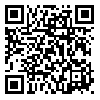

1- Qom University of Medical Sciences
2- Occupational Health Engineering Department, School of Health, Work Health Research Centre, Qom University of Medical Sciences
Abstract: (4464 Views)
|
Background & Aims of the Study: Musculoskeletal disorders (MSDs) are part of the main occupational diseases in the workplace. Occupations such as hairdressers are exposed to multiple risk factors of these problems. The study was conducted to assess MSDs and posture analysis among female hairdressers in Tehran, 2015.
Materials and Methods: In this cross-sectional research, 114 participants were studied. To collect data, demographic questionnaire, body map for assessment of MSDs and Postural Loading on the Upper Body Assessment (LUBA) method to evaluate postures was used. Also, data were analyzed by Mann-Whitney, Kruskal Wallis and Spearman correlation tests through SPSS-V20.
Results: The mean and standard deviation of age and experience of the participants were5.34±8.9 and 10±8 years, respectively. In addition, they worked 9.8 hours per day on average. One hundred and thirteen (99.12%) persons have experienced the pain at least in one member of their musculoskeletal system. Most of hairdressers had reported leg, lower back, as well as neck and shoulder pain. According to the posture assessment, 94.2% of people experienced high risk of exposure to risk factors for MSDs.
|
|
Conclusion: Findings showed MSDs are high among barbers. Also, the work situations require immediate correction. Correction of workstations and tools design, work rest cycle and reduction in repetitive motions can help to improve working conditions.
Type of Study:
Original Article |
Subject:
Occuptional Health Received: 2016/09/1 | Accepted: 2016/11/25 | Published: 2016/12/29









